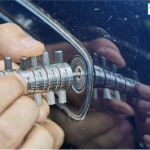Like many homeowners, you might want to avoid the complexity and expense involved in re-roofing your home using conventional roofing materials of the shingles variety. If that’s the case, a solid alternative for you is rolled roofing, a material that’s cheaper and easier than the shingle-type materials. Moreover, you can install it yourself, albeit in a way that’s limited.
Some might say that rolled roofing is too good to be true, and in some ways they might be right. So before you scurry off to the home depot to pick up some rolls, here’s what you should know about this type of roofing material.
The bottom line:
- Cost – 100 square feet go for about $50-$75, including the cost of the material itself as well as the 11-gauge nails used for roofing. In other words, rolled roofing is the most affordable option because the materials are cheap and labor is free if you install it yourself.
- Defined – Technically referred to as mineral-surfaced roll roofing (MSR), rolled roofing comes in 100-square-foot rolls that can be easily obtained at most home improvement stores.
- Adaptable – Rolled roofing can be cut into strips of 12” by 36” to be used as hips and ridges or 9-inch strips to be used for eaves and rakes.
- Installation – Most suitable for garages, shops, sheds and other outer buildings. It’s not the preferred material for the main home by most homeowners.
- Re-roofing – It’s usually okay to re-roof over your existing roof using rolled roofing provided you first remove the gravel, slab and other debris to prevent puncturing the rolled roofing material.
- Easy handling – It’s usually a daunting and dangerous affair to move composite shingles to the roof from the ground level. It’s a job best left to professional roofers in Merseyside who use forklifts and cranes. In contrast, you can move the 75 lb. of rolled roofing material with the assistance of one partner or even by yourself.
Advantages of rolled roofing over shingles
Individual composite (asphalt) shingles are the most common way of roofing a structure. The quality shared by rolled roofing and composite singles is that both are products of oil-based asphalt. That’s where the similarity stops. Rolled roofing is larger, thinner, less durable and cheaper. It’s also installed horizontally in long strips.
Various types of rolled roofing serve as supplements to other materials for roofing. For instance, saturated felt, an asphalt-impregnated builders-grade, is commonly used for underlaying.
Sizing, cost and applications
One “square” of MSR roofing roll is 100 square feet. It’s approximately 36 inches wide and 36 feet long, which makes it equivalent to one “square” of composite shingle material in terms of quantity. Black roll roofing material alone with cost you approximately $55 per square and you will fork out another $5 per 400 count of roofing nails that are corrosion-resistant.
Rolled roofing is used mainly for functional buildings and low-roof pitches. Rarely is it used for the main house or other structures that typically attract attention. As well, it’s used for low-sloped roofs.







